
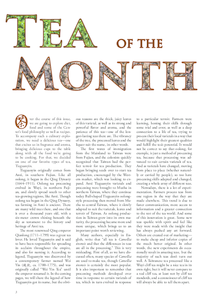 |
|

Over the course of this issue, we are going to explore diet, food and some of the Center's food philosophy as well as recipes. To accompany such a culinary exploration, we need a delicious tea - one that excites us in fragrance and aroma, bringing delicious cups to the table along with all the food we're going to be cooking. For that, we decided on one of our favorite types of tea, Tieguanyin.
Tieguanyin originally comes from Anxi, in southern Fujian. Like all oolong, it began in the Qing Dynasty (1644 - 1911). Oolong tea processing evolved in Wuyi, in northern Fujian, and slowly spread south to other tea-growing regions, like Anxi. Though oolong tea began in the Qing Dynasty, tea farming in Anxi is ancient. There are many wild trees there, and one that is over a thousand years old, with a six-meter crown shining beneath the sky as testament to the history and heritage of Anxi tea.
The most renowned Qing emperor Qianlong (1711 - 1799) was a great tea lover. He loved Tieguanyin and is said to have been responsible for spreading its acclaim throughout the empire, and also for naming it. According to legend, Tieguanyin was discovered by a contemporary farmer named Wei Yin (魏飲, ca. 1700 - 1775), and was originally called "Wei Yin Tea" until the emperor renamed it. In the coming pages, we will share the legend of how Tieguanyin got its name, but the obvious reasons are the thick, juicy leaves of this varietal, as well as its strong and powerful flavor and aroma, and the patience of this tea - one of the longest-lasting teas there are. The vibrancy of the tree, the processed leaves and the liquor suit the name, in other words.
The first waves of immigration from the Mainland to Taiwan were from Fujian, and the colonists quickly recognized that Taiwan had the perfect terroir for tea production. They began bringing seeds over to start tea production, encouraged by the Western market, which was looking to expand. Anxi Tieguanyin varietals and processing were brought to Muzha in northern Taiwan, where they continue today. Ball-shaped Tieguanyin oolongstyle processing then moved from Muzha to central Taiwan, where it slowly adapted to suit the varietals, leaves and terroir of Taiwan. As oolong production in Taiwan grew into its own maturity, the processing became more and more unique, which brings us to an important point worth reviewing.
Many authors, especially in English, write that "all tea is Camellia sinensis and that the differences in teas are all in the processing." This is very misleading. First of all, as we have discussed often, many species of Camellia are used to make tea, though Camellia sinensis is certainly the most popular. It is also important to remember that processing methods developed over time in response to certain varietals of tea, which in turn evolved in response to a particular terroir. Farmers were learning, honing their skills through some trial and error, as well as a deep connection to a life of tea, trying to process their local varietals in a way that would highlight their greatest qualities and fulfill the tea's potential. It would not be correct to say that oolong, for example, is just a method of processing tea, because that processing was advanced to suit certain varietals of tea. And as varietals have changed, moving from place to place (whether naturally or carried by people), so too have processing skills adapted and changed, creating a whole array of different teas.
Nowadays, there is a lot of experimentation. Farmers process teas from one region in the way that they are made elsewhere. This trend is due to faster communication, more access to information and a greater connection to the rest of the tea world. And some of this innovation is great. Some new teas sparkle with spirit and feel like they were made with the insight that has always pushed any art forward. Others are created out of marketing - to make cheap and inferior copies of the much better original. In other words, the new experiments do occasionally result in amazing teas, but the majority of such teas don't turn out well. A Taiwanese tea processed like a Wuyi cliff tea might be a nice tea in its own right, but it will never compare to a real cliff tea, at least not by cliff tea standards, and a connoisseur of cliff tea will always be able to tell them apart.
Unlike most other kinds of tea, Tieguanyin is best picked at noon, rather than early in the morning. The strong leaves of this hearty varietal thrive in the sun. The leaves are thick and strong. Like all oolong teas, the best method is to pick one bud and two leaves in sets, though most farmers nowadays pick larger sets to increase yield.
Traditional oolong production is semi-oxidized, usually between 40% and 70%, with some outliers like Eastern Beauty, which has heavier oxidation. All of the processing steps in Tieguanyin take into account the thicker, tougher leaves of this varietal, which furthers the argument we just discussed that processing techniques evolve to suit certain varietals. This starts with the withering, which is usually piled more deeply than other types of oolong. The outdoor withering is usually short, and depends on the sun. The indoor withering also lasts longer than other kinds of oolong and can take as long as fifteen to even twenty-four hours.
The most defining step in all oolong production happens during the indoor withering, as the leaves are shaken every hour or so to bruise the edges of the leaves. This breaks the cells down, oxidizes the edges more and makes the tea more flavorful. The best oolong leaves will have a red rim around the edges after brewing, but this can only really be achieved when the processing is done by hand. Most oolong nowadays is shaken in large tumblers, which do not bruise the leaves so perfectly or uniformly, and rarely just on the edges. The withering and shaking will continue until the farmer is satisfied with the aroma of the tea leaves, which are checked regularly.
The oxidation process is then arrested by firing. (This is technically not true as oxidation will continue in the tea indefinitely, which is what happens when you age an oolong tea, but it does slow to such a molasses drip that we can, for all practical purposes, say that it is halted.) The firing of oolong is done in large metal woks, traditionally heated from underneath using a woodfire stove. The duration of the firing depends on the moisture content in the leaves.
Immediately after the firing, the tea is rolled. Tieguanyin is a ball-shaped oolong, which means it is rolled in a twisted-up cloth bag. Traditionally, this was done with the feet, though nowadays the ball-shaped bag is rolled over metal ridges by a machine that presses the bag down and spins it in a circle. This vigorous rolling is yet another example of the ways in which processing techniques have evolved to suit certain kinds of tea. The rolling of tea is to break down the cells and bring the juices to the surface for brewing. It also shapes the tea. Tieguanyin is, of course, the first ball-shaped oolong. The thickness of the leaves means that the striped-oolong-rolling, across ridged bamboo trays, like the first-ever oolong, which is Wuyi cliff tea, would not be strong enough to break the cells of Tieguanyin leaves down. Also, the shape wouldn't hold, since the leaves are so tough. A more rigorous rolling was required. Rolling cliff tea in a bag like that would damage the more delicate leaves used to make yancha.
After the rolling, the tea is roasted at a low temperature to dry it out. Eventually, it will get a finishing roast. Traditionally, Tieguanyin is the most roasted of all oolongs, often for up to seventy-two hours! You can think of the traditional processing of oolong as a glass in which the oxidation and roast work together to fill it up, starting with the fact that such oolongs were oxidized 40 - 70%. In other words, an oolong oxidized to 40% has more room for roast, whereas one oxidized to 70% has less roast. (This doesn't apply to modern, lightly-oxidized oolongs, which are fragrant, light and floral, and a heavy roast would therefore just burn them.) Back in the day, farmers would often send maocha (unfinished, rough tea) to shops who would roast it to their customers' tastes. Roasting skills are often very secret, passed down from father to son and held as dear as great recipes at famous restaurants. With the popularity of Taiwanese oolong, Anxi Tieguanyin has also started to trend towards more lightly-oxidized and roasted teas, making many green varietals these days, which brings us to the issue of what traditional processing is and the changes in oolong production in Taiwan.
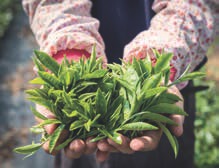
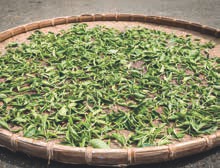

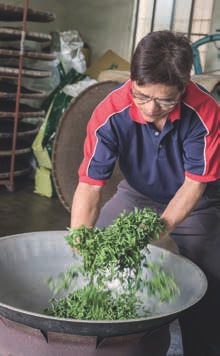
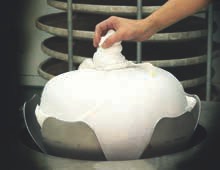
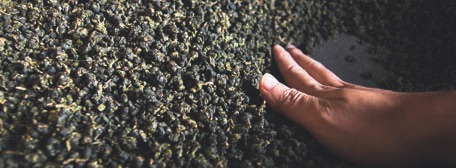

In the 1970s, everything was "Made in Taiwan" the way it is in China today. This industry brought prosperity to Taiwan. As Emperor Huizong said in the Treatise on Tea we published in April 2017, it is only when the land is prosperous and peaceful that people can pursue art and culture like tea. And as Taiwanese people started developing, and food, shelter and life were all abundant, they started refining and exploring their rich Chinese heritage and culture, including, of course, tea, teaware, brewing methodology, etc. There was a boom in tea, which drove demand through the roof. Small, aboriginal tea farms slowly started changing into large plantations, owned by the families themselves or sold to larger corporations. This demand, and the need for greater quantities of tea, drove tea production into territory that was previously uncharted for oolong tea, facing new obstacles and challenges along the way.
Traditional oolong processing is the most complicated and skilled of all tea production. This is not to say that it takes little skill to make a fine green tea, for example. It does. But traditional oolong is more complicated and delicate and there's a narrow margin of error - misprocessed leaves are rigorously down-sorted (even more so in less profitable yesteryears). It takes decades to master. In fact, it will be decades before a son is allowed to supervise an entire production with confidence. And one thing we all love about tea is that it comes to us an unfinished leaf. So much of the quality is changed with brewing skills, in other words. Those of you with experience brewing traditionally processed oolong will know just how finicky, sensitive and ultimately unforgiving it can be. It requires the most skill (gongfu) to prepare well, and sometimes preparing it well makes all the difference between a glorious and sour cup! Taking decades to master processing that requires great skill, a tight margin of error and the necessity of brewing skills to make a fine cup are all not conducive to increasing quantity and accessibility to the mainstream demand for tea that occurred at the time. Farmers needed tea production that was mechanized and easy to master, allowing employees to be trained in a matter of weeks; they needed a wide margin of error, so that even slightly misprocessed leaves would go unnoticed; and they needed the tea to be easy to prepare, so that consumers could put it in a thermos, a tea bag, a mug or a pot and it would turn out fine. They needed lightly-oxidized oolong.
Light oxidation and little to no roasting produces a greener kind of oolong that is easier to make, has less margin of error and can be brewed any way you like, maintaining a bright, flowery fragrance that appeals to the mainstream. This shift in tea production later moved to the Mainland, as well. It changed a lot in the tea world, including teaware, tea brewing and even puerh scholarship. As a result of these changes, many Taiwanese tea lovers began switching to puerh because they didn't like these domestic changes. Their interest reinvigorated a deteriorating puerh culture.
While lightly-oxidized oolong can be wonderful, it is often very fragrant without much of a body. It is also rarely produced in a healthy, sustainable way that is good for the Earth. Most of the time, it is more like a tasty appetizer than a good meal. You may have prepared a lightly-oxidized oolong for guests and then looked around wondering what tea to drink next afterwards. Tea lovers are rarely satisfied by such a tea, in other words. (That also suits the producers, of course, since they then drink more tea.) There are exceptions to this, but usually traditionally-processed oolong tea is more rich, full-bodied and satisfying to drink. There's a reason that farmers adapted their processing the way they did, to bring out the best in oolong varietals; and there's also a reason why it went relatively unchanged for centuries. Creating lightly-oxidized oolong did breathe some fresh air into the oolong world, resulting in many new innovations and some wonderful new teas, but for a while, the new swallowed the traditional whole.
When the market started, somewhat mistakenly regarding altitude as equivalent to quality, lower-altitude farms lost a lot of patronage. Some switched to organic and/or traditional processing to make themselves stand out from greener, high-mountain oolong tea. As a result, traditional processing has once again become popular in Taiwan, which is a great thing for those of us who appreciate it more. No matter how you feel about lightly-oxidized oolong, it is nice to have both. We just hope that more of the greener oolong producers will start making the switch to organic, Earth-friendly agriculture, as it is definitely not a genre known for clean tea (which is, of course, another reason we don't drink much of it at the Center).
It is very difficult these days to get organic Tieguanyin from either Anxi or Muzha. We know a few organic farmers in Muzha, like the producer of our Light Meets Life aged Tieguanyin, but their tea is far too expensive for Global Tea Hut. In order to create a Tieguanyin that was delicious, very clean and affordable, we turned to our dear Master Xie. Wu De and Master Xie once again exchanged samples back and forth for three months, discussing and tweaking what they wanted to create, which resulted in this wonderful Tieguanyin. Before we turn to our Tea of the Month, however, we should introduce Master Xie once again.

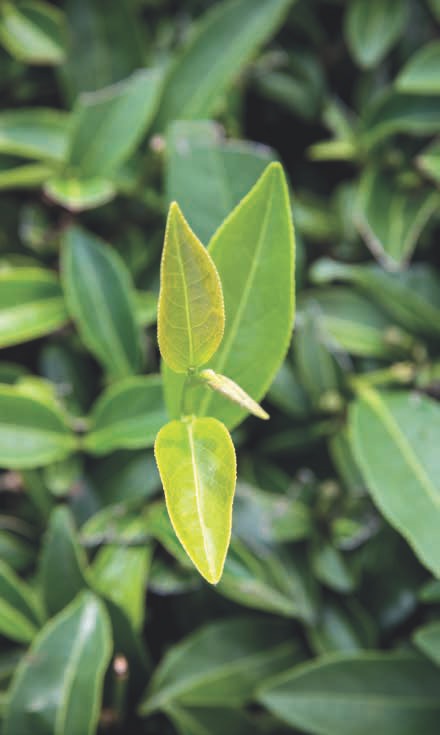
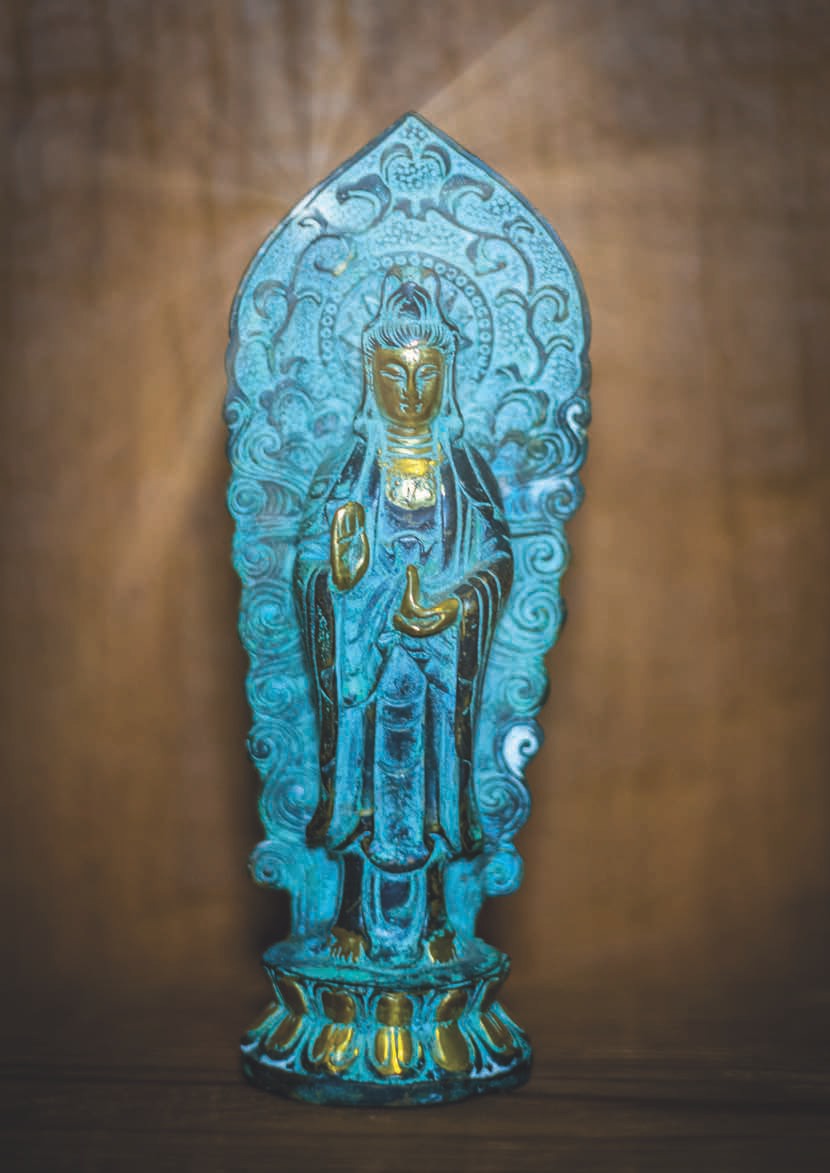
Like most Tea stories, this one starts with a farmer... Wei Yin was simple, and like Tea, his best qualities were hiding in plain sight. He went about his chores, tending his tea trees with the same reverence his father and father's father had, as his people had done beyond memory to the legends that Wei Yin would one day join. Every day, he would spend hours in the fields or quietly walking to and from them. There were holidays, weddings and funerals, but most days Wei spent pruning, harvesting, processing and carrying tea to market. Wei Yin didn't talk much, not even to his own wife, but not in a pensive or unfriendly way. He was just simple, shy and uncomplicated, which is to say pure of heart.
When Wei was in his fifty-fourth spring, there was a great drought and many people lost their tea farms, let alone their vegetables and grain - for everyone knows tea is a tree heartier than most. When the following year threatened to be the same, some of his neighbors packed up, abandoned their homes and left to start new lives in the South. But Wei couldn't leave. He had a secret.
When Wei Yin was young, at the time before he was married and when his father was still alive, he once came upon an old hermit on one of the paths that meandered through the forested hills to the tea gardens. Immediately, the young man knew that the old man was special - maybe even an immortal. He followed the old hermit back to his home, which was a small temple in the forest near Wei's neighbor's tea garden. The old man lived in a tiny shrine devoted to the Goddess of Mercy, Guanyin. He told Wei that the temple had been there for centuries. The old cast iron statue certainly looked worn enough to have been there that long. It was the oldest thing Wei had ever seen.
Over the years, Wei visited the old monk regularly, bringing him the choicest tea from their harvest and sometimes rice. The old man would sometimes teach Wei life lessons by telling him old stories, though most of the time they just sat together enjoying the peace of the forest shrine.
Years later, when the old man grew very ill, he told Wei that his young apprentice had gone traveling years earlier and never returned. He told him that he needed Wei to tend the shrine after he was gone. "For not a single day," the master began in a frail voice, "not since even my master's master was young, has there been a day without candle and incense on this altar for Guanyin. These prayers must continue." Wei was honored to tend the temple. He would leave early every day and stop on the way to the fields to pray, sitting beneath the altar for one hour a day. Over time, this practice began to change Wei. He grew more and more soft. He wasn't distant or withdrawn, nor would his neighbors have ever suggested he was unfriendly. "He's a quiet man," they would have said. "And for some reason, I like him."
When the third year without rains came, Wei's wife became very afraid, especially since Wei continued spending a large portion of their savings on candles and incense to tend the shrine. When she would confront him, however, Wei would say that now was the time for more prayers, not less. "No drought lasts forever. And if we cannot accept the times when the Heavens give us less, how will we rightfully celebrate the times when we are given more?" And since there was a lot less farm work to do, Wei did just that: spending more and more time at the little shrine in prayer and meditation. He continued to offer Guanyin the finest teas, candles and incense he could buy, despite his dwindling savings. Once a month, he would carry firewood to town to sell for pittance, which was enough to buy some rice for him and his wife.
One night, Wei was at the small shrine praying. He had walked all the way to market that day after chopping wood all morning and was therefore extremely weary. His eyes flickered like the candles and he strayed into a dream... He was walking with his old master, just a step or two behind out of respect, as he had always done. The old man's white topknot was shining, and he had a translucence that was different from how Wei Yin would have remembered him when he was awake. They were walking along a path by the riverbank, where they had often wandered, slowly, as people stroll through Nature when they are free. But in the dream, Wei could sense a purpose to the old man's steps, as if he was taking him somewhere. Soon, they left the path and began walking up through the underbrush. The way was steep, and the walk soon became hard work. After some time, they came upon three boulders. The old man stroked the first fondly, patting it the way you would an old friend's back. When they walked around the stone, Wei Yin couldn't believe his eyes, for there in a small clearing sat Guanyin herself!
She was more gorgeous than anything he had ever seen. The white of her dress shone like the purest moonlight embroidered with dew. Her skin was porcelain and Her eyes shone like diamonds - clear and sharp, but full of the strongest love and kindness he had ever experienced. It was as if every loving glance of his wife, every smiling eyes of a friend and all the caring gazes of his mother were all in Her eyes. Wei Yin fell to his knees and cried. He cried for the joy of Her. She gently raised his tearstreaked face to Hers, and through the warp and woof of the tears, She glowed. With the softest and sweetest touch, she bent down and kissed his forehead. She smelled like cinnamon and osmanthus. "Wake up," she said in a voice more beautiful than the flute he had heard once in town. "Wake up... wake up..." echoed in his mind like temple chants, uplifting and calming him at once - like Tea... Wei Yin's eyes fluttered open and he was in the small shrine. The candle had burned low. He reached up and felt the wetness of his face, covered in tears.
The next morning Wei Yin left home before dawn. With a purposeful stride, he made his way to the river, now a rock bed due to the drought. After some time, he found the exact spot where he and the old man had left the path and cut into the underbrush. He struggled up the steep slope without a doubt in his heart, excited and smiling beneath the canopy of trees. After an hour or so of arduous hiking, he found what he sought: the three boulders. He pat the first one with a smile, just as his master had in the dream. With a reverent cautiousness, he made his way around. Sure enough, there was a small clearing just as he had dreamed. And there in the center of the clearing was the healthiest, greenest and brightest tea tree he had ever seen...
Years later, all the farmers for miles around had gardens full of trees descended from Wei Yin's strong tree and the tea from that region was known as "Wei Yin" tea. He never charged his neighbors for the seeds, wishing them health and prosperity when they came for them. He happily gave them away without even a thought of recompense, or even his reputation. He cared more about the old shrine. The hearty trees could survive even the harshest drought, produced much more tea than any tea tree the villagers had heard of, and, most importantly, the leaves were sweeter, more fragrant and delicious, tasting of cinnamon and osmanthus. Though the fame of this magical tea spread far and wide, and even to the Dragon Throne, Wei Yin was far too humble to feel responsible, and opposed to the tea bearing his name. He'd be happy to know we speak of her by her true name nowadays, though we haven't forgotten the power of faith...
Aside from providing this month's tea, which you are sure to love, Mr. Xie is a very important part of the scenery at our Center, and will be very important for many of you as well, because so many of our visitors come here with a curiosity about how tea is processed. It is very important to experience with your own hands just how difficult it is to make tea, so that in your own soreness you will develop a tremendous respect for the Leaf. This respect isn't just in the billions of years of evolution or in the Nature we always wax poetic about: the wind and rain, sun and moonshine, minerals, mountain and water that flow from roots to crown. It is also in the blood, sweat and tears of generation after generation of farmers. And there is a deep reverence in seeing just how much mastery, skill and, dare we say, art in the crafting of the Leaf. And so, with great joy we take as many of our guests as possible to a few different farms to try their hands at tea processing. It is amazing to make your own tea and take it home with you. If you didn't have enough reasons to come stay with us, here's another: Mr. Xie has formally invited each and every one of you to come to his farm and make tea, eat a nice lunch and take the tea you picked and crafted home with you!
Mr. Xie is a third-generation farmer in Mingjian, Nantou, central Taiwan. Mingjian is lower altitude, in the foothills of the central mountain range. In the last few decades, such lower-altitude tea has been adumbrated by the popularity of the teas grown higher up. Though areas like Hsinchu and Miaoli counties, where Eastern Beauty is grown, have struggled since high-mountain oolongs have come to dominate the market, Mingjian has prospered by providing lower-priced teas for export or large-scale production for the bottled tea market (often called "Ready to Drink," or "RTD"). Mr. Xie's family has grown small-scale productions of oolong tea through three lifetimes, since before the higher teas even existed, and certainly before pesticides existed in the world, let alone Taiwan.
When we discuss organic farming and the need to make changes in tea farming - as well as other kinds of agriculture - it's important to remember that the farmers are always the first victims. It is they who handle the agrochemicals in large amounts, and most directly. Furthermore, it is only by humanizing and befriending them that we can bring about change. We must include rather than exclude - educate rather than ostracize. Like so many other farmers, Mr. Xie started to get the nagging (coughing, wheezing) feeling that these chemicals were harmful to his family, his community and his land. When his wife almost miscarried their second child in 1997, he had enough. Despite opposition from friends and family, Mr. Xie made a commitment to become an organic tea farmer, no matter the cost. He first attended some organic farming classes held by the MOA Organization.
From 1997 to 2000, Mr. Xie and his family struggled to maintain their principles. His tea was subpar and he lost most of his customers. His father, who had been worried when he suggested upsetting the status quo in the first place, was very critical of his decisions. Organic farming is difficult, and it requires a radical change in farming and processing methodology - changes that would take time to learn. Rather than give up, as many would have done, Mr. Xie got a part-time job as a painter and carpenter, working day and night - either painting or farming - to keep his family afloat. Finally, in the early 2000s, his acumen for organic farming improved to the point that he was able to take his teas to market again. Since then, he has gone on to win awards, been featured on TV and has even heard his father, now a sprightly eighty years old, bragging to others about how his tea is organic and good for the environment.
Mr. Xie's work hasn't stopped with his own farm. He knew that he would have to keep improving his skills, creating new and better teas, and help show his neighbors the value of organic farming, especially since their land and
his are close enough to influence each other. He formed a co-op with other farmers and began teaching locals to shift to organic methods, offering them equal shares in their combined enterprise. As more people have joined this local group, the incentive to do so has also increased. To date, more than twenty farmers in the Mingjian region are organic, including Mr. Xie's immediate neighbors.
Mr. Xie's kind heart shows in his teas. He cares deeply about tea and the Earth. He produces green tea, largeand small-leaf red tea, as well as several kinds of oolong, and all with great skill. He's generous with his tea, supporting our efforts selflessly. To us, he is an inspiration and a kind of hero - the kind not talked about enough these days. It's easy to follow the crowd, maintain the status quo; or to say, "I am just one person. What can I do?" It is difficult to face criticism from family and friends and stand up for what you believe to be right. The problem is that it is too easy for farmers to make more money with agrochemicals, and to do it with less work. And that's also why so many of them are overusing the fertilizers and pesticides, reducing the average life of a tea bush to fifteen years, all in the name of personal gain. Many of them get cancer from improper exposure to such chemicals, themselves victims as we mentioned above. Mr. Xie is a man who has seen a different way, and, more inspiringly, lived that way and taught others to do so. And that is the spirit of Tea!


There are no Tieguanyin trees in Taiwan outside of Muzha, so we had to turn to "Four Seasons of Spring (四季春, Si Ji Chun)," which is a direct descendant, and one of the "Three Daughters" of Taiwan. Though you could perhaps call Si Ji Chun a hybrid, it is a natural, wild varietal that arose in Muzha. Since it is a more natural varietal, it is heartier than the other daughters (Jing Shuan, 金萱; and Tsui Yu, 翠玉). This is a testament to one of the principles we always promote in these pages when discussing what we call "living tea," which is that the leaves produced by man will never compare to Nature's. It's possible to further distinguish manmade teas by calling them "cultivars." These trees yield buds at least four times a year, which is where its name comes from. "Si Ji Chun" might also be translated as "Four Seasons Like Spring," referring to the fact that this bush can produce as much in other seasons as in spring. It is also thought to be the youngest of the Three Daughters, coming into commercial production in the 1980s. Si Ji Chun does not have a Taiwan classification number, since it evolved naturally. The leaves of Si Ji Chun are round in shape, with veins that shoot off at 30- to 60-degree angles. The leaves have a light green hue. The buds of Si Ji Chun are often a gorgeous reddish hue when they emerge, which is due to a pigment called anthocyanins (covered in the August 2017 issue).
Si Ji Chun has an exuberant, golden liquor that blossoms in a fresh, musky floweriness. It is tangy, with a slightly sour aftertaste, like the Tieguanyin varietal it evolved from. Many Taiwanese compare the aroma to gardenias. It works well as a heavily-roasted Tieguanyin, bringing many nuances in flavor and aroma to the cup that aren't ordinarily there, which is perfect for an issue all about food. While it is an innovation in terms of producing Tieguanyin, it is not a great stretch, as Si Ji Chun is a wild offspring and therefore not too different from one of the wild varietals in Anxi. The floral undertones of the varietal bring complexity to an already rich tea. Tieguanyin is amongst the most aromatic and flavorful teas in the world and this month's is no exception. You will be delighted by just how much each and every cup offers, let alone the shifts of a journey through a session.
This is a bright and very delicious cup, with deep orange, spicy brews. We love the way that Tieguanyin is both sweet and sour at the same time, with a pungent tanginess and the lasting aftertastes that only a well-made oolong can achieve. This tea is very deep, lasting many steepings, each with a complexity that is inviting. Such sessions are like journeys, soaring on the back of the "black dragon" through the clouds to visit distant vistas. We love drinking this tea in the late afternoon or early evening.
The Qi is cleansing, pushing outward from the center. It rises up in gusts and leaves you feeling refreshed. It is uplifting and airy, bringing movement towards the distant mountains. This is a beautiful and warming tea for the winter, bringing rich spice and vast movement with each session. We enjoy drinking such a tea over the course of a very free afternoon - hopefully with some nice tea companions!

This month's tea is best enjoyed gongfu. Gongfu tea and oolong tea were born, raised and matured into wisdom together. Though one can prepare many teas gongfu, there is no better tea for this brewing style than oolong. And Tieguanyin is amongst the original gongfu teas. Only gongfu brewing will bring out all the subtle nuances of this rich tea, let alone preserve the incredible patience over thirtyish steepings. However, if you cannot brew gongfu, don't have the right teaware or aren't interested, you can put a few balls in a bowl and watch them open for a few glorious bowls. In fact, we recommend doing this once even if you are brewing the tea gongfu, just for the experience. (It only takes two or three balls, after all, so you have plenty of tea for both.)
When we share a tea that is more conducive to gongfu brewing, we often use the word "flash" in the suggestions on the bottom of the opposite page. Some of you have asked us about this, so we thought we would explain in more detail. A flash steeping means an immediate steeping, without any time at all. In other words, we aim to decant the liquor without a pause at all - directly after showering the pot. With high-quality, fine teas, we usually start with a slightly longer initial steeping to open the leaves. Then there is a flash steeping once they are open, which is often the most delectable of steepings (though do not get stuck in only appreciating early steepings, as we have often discussed, for there is great joy in later steepings as well). A really fine tea can be flash steeped multiple times - even up to three or four times. Our Tea of the Month can usually respond well to two flash steepings. After the flash steepings, we can then start to increase the duration.
Try to learn from experience and don't be afraid to make mistakes. We usually avoid offering brewing tips in terms of time, temperature or amount in grams as these force us to rely on scales, timers and thermometers. These devices can make things easy, but become crutches towards real skill (gongfu). Also, brewing tea in such a way can interfere with the mindfulness we cultivate through a tea practice, let alone the ceremonial ambiance, if you enjoy either of these. Learn by brewing. Gauge the amount by the tea and pot and steep by feeling. Practice with this month's tea, increasing steeping time after the flashes through the heart. Listen to the tea...